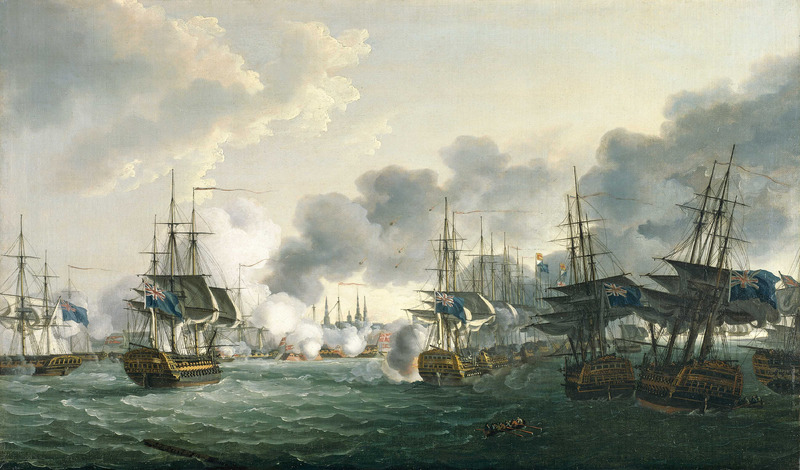Image: The Battle of Copenhagen, 2 April 1801 RMG BHC0528f

Description: The Battle of Copenhagen, 2 April 1801 In 1801 the northern powers of Russia, Denmark, Sweden and Prussia, the last three under pressure from the mentally unstable Tsar Paul I - formed an armed coalition that constituted a threat to British interests in the Baltic. A British fleet under Admiral Sir Hyde Parker, with Lord Nelson as his second-in-command, was therefore dispatched to disrupt it. Having negotiated the Sound without hostile fire from the Swedish side, Nelson proposed an assault on the Danish fleet anchored in a defensive formation off Copenhagen. By 30 March the fleet anchored off the Swedish island of Hven, 15 miles from Copenhagen. Nelson took the lighter ships of the squadron - of 74 guns and less - south of the city via the Hollands Deep, the outer channel east of the Middle Ground shoal, while Parker with the larger vessels remained to the north. The next night Captain Hardy took daring soundings to assess the depth of water within yards of the Danish line, the Danes having removed all navigational marks as part of their defence. The fleet moved in for the attack on 2 April, sailing north up the King's Deep on the western side of the Middle Ground and anchoring abreast of the Danish line under heavy fire. Nelson was in the 'Elephant', 74 guns, and was accompanied by nine other ships of the line, two 50-gun ships, six frigates and two sloops, together with bomb-vessels and fire-ships. Early on, the 'Bellona', and 'Russell', both of 74 guns, grounded on the south-western end of the Middle Ground shoal and the 'Agamemnon', 64 guns, also proved unable to weather the shoal's southern tip. Such losses placed a heavy burden on the frigates close to the northern end of the Danish line. Although Nelson was ordered by Sir Hyde Parker to withdraw when it seemed that his ships were in great danger, he continued the bombardment and forced the Danes to negotiate a truce after severe loss of life. The picture is viewed from the south end of the King's Deep and shows the British fleet flying the blue ensign. In the right foreground the 'Russell' and 'Bellona', are shown in port-quarter view, their sharply pitched position indicating that they have gone aground, though they remained in action (Captain Thompson of the 'Bellona' losing a leg). The stern of the 'Agamemnon', in starboard-broadside view, is visible in the extreme right foreground. Also in the right foreground is a boat rowing towards the stranded ships. To the left and beyond these are ships of the British line, in starboard-quarter view, firing their port broadsides at the Danish line moored, port-bow view, in the centre and left background of the picture. In the left foreground is a single British ship, in starboard-quarter view, moving into action and on the extreme left is the 40-gun frigate 'Désirée', partly shown in port-quarter view. It is moored across the bows of the leading Danish ship, the 'Provesteen', 56 guns, and raking her. The skyline of Copenhagen rises above the gunsmoke in the centre background, the distinctive spiral tower of the Bourse being notable. The artist was the son of Dominic Serres and although he began his career as a landscape painter he followed the pattern set by his father. He travelled to Paris, Rome and Naples before he succeeded his father as Marine Painter to George III in 1793. He favoured painting sea-pieces in the European tradition and after becoming Marine Draughtsman to the Admiralty in 1800 made drawings of the coasts of France and Spain published in his book, 'The Little Sea Torch', in 1801. In 1805 he also published 'Liber Nauticus', a treatise on marine draughtsmanship containing engravings of his father's drawings. He was eventually ruined by the bizarre and extravagant behaviour of his wife, a self-deluding fantasist who styled herself 'Princess Olive of Cumberland'. He died in debtors' prison, after creating a set of large watercolours recording his experiences there. The painting is signed and dated 'J T Serres 1801'. Copenhagen by Serres
Title: The Battle of Copenhagen, 2 April 1801 title QS:P1476,en:"The Battle of Copenhagen, 2 April 1801 " label QS:Len,"The Battle of Copenhagen, 2 April 1801 "
Credit: http://collections.rmg.co.uk/collections/objects/12020
Author: John Thomas Serres
Permission: The original artefact or artwork has been assessed as public domain by age, and faithful reproductions of the two dimensional work are also public domain. No permission is required for reuse for any purpose. The text of this image record has been derived from the Royal Museums Greenwich catalogue and image metadata. Individual data and facts such as date, author and title are not copyrightable, but reuse of longer descriptive text from the catalogue may not be considered fair use. Reuse of the text must be attributed to the "National Maritime Museum, Greenwich, London" and a Creative Commons CC-BY-NC-SA-3.0 license may apply if not rewritten. Refer to Royal Museums Greenwich copyright.
Usage Terms: Public domain
License: Public domain
Attribution Required?: No
Image usage
The following 3 pages link to this image:

